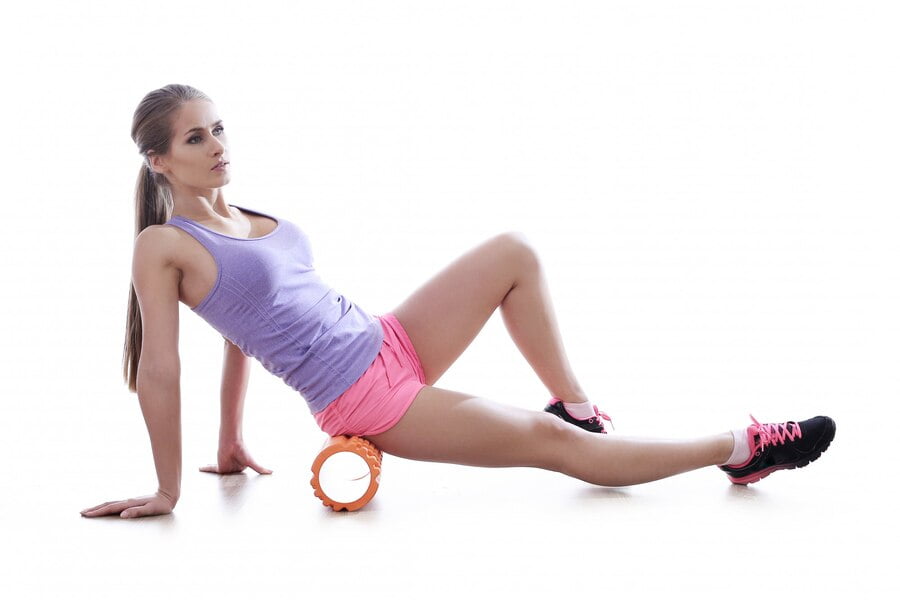
Foam Roller for Sciatica Relief, 2024 best guide
Last updated on December 12th, 2025 at 05:58 pm
Foam Roller for Sciatica Relief: Most people don’t know what sciatica is until they feel a sharp, electric-like pain in their legs. Sciatica symptoms often come with muscle stiffness, making it hard to live a normal life. Using a foam roller can be a great way to relieve sciatica pain from the comfort of your home.
Whether you are new to foam rolling or looking for ways to reduce your sciatica pain, this guide is for you. Let’s explore how foam rollers can help ease sciatica pain.
Table of Contents

How Foam Rolling Helps with Sciatica
Sciatica is a condition where pain spreads along the sciatic nerve, which can be very painful. Foam rolling is becoming known as an effective way to reduce the symptoms of sciatica. However, using a foam roller on the lower back is usually not good because it can put pressure on the spine. A foam roller is a great tool for home treatment, especially when used with other home remedies for sciatica.
Foam rolling involves using a special foam roller to apply pressure on specific muscles. This pressure helps to release tension and knots in the muscles, especially those around the sciatic nerve. Sciatica is often caused by pressure or irritation of the sciatic nerve, which is frequently due to tight muscles in the hips and lower back. Foam rolling helps to loosen these tight muscles, reducing the pressure on the nerve and improving blood flow to the affected area. Additionally, foam rolling can stimulate the release of the body’s natural pain-relieving chemicals, called endorphins, which can further reduce discomfort.
A foam roller is a great tool for home treatment, especially when used with other home remedies for sciatica.
Read More: 16 Best Stretching for Sciatica Pain Relief
How to use Foam Roller for Sciatica Relief:
Foam rolling can be a valuable tool in managing sciatica symptoms by targeting key muscle groups that may contribute to pain and discomfort. Here are step-by-step instructions for foam rolling exercises focusing on areas affected by sciatica:
1. Gluteal Muscles:
- Sit on the foam roller with one knee bent and the other ankle crossed over the bent knee.
- Lean slightly to the side of the crossed leg and shift your weight onto that glute.
- Roll back and forth, focusing on areas of tightness and discomfort.
- Repeat on the other side.
2. Piriformis Muscle:
- Sit on the foam roller with both knees bent and feet flat on the floor.
- Cross one ankle over the opposite knee, placing the ankle just above the knee.
- Lean slightly toward the crossed leg and shift your weight onto that side.
- Roll back and forth, targeting the piriformis muscle located deep in the glutes.
- Repeat on the other side.
3. Lower Back:
- Lie on your back with the foam roller positioned horizontally under your lower back.
- Bend your knees and place your feet flat on the floor for support.
- Lift your hips slightly and roll up and down along your lower back, focusing on areas of tension.
- Avoid rolling directly over the spine.
- Use your feet to control the amount of pressure applied.
4. Hamstrings and IT Band:
- Sit on the floor with your legs extended and the foam roller positioned under your thighs.
- Place your hands behind you for support.
- Roll back and forth along the length of your hamstrings, from the glutes to just above the knees.
- To target the IT band, rotate your body slightly to one side and roll along the outer thigh from the hip to just above the knee.
- Repeat on the other side.
Benefits:
- Relieves Muscle Tension: Eases tight muscles around the sciatic nerve.
- Boosts Circulation: Improves blood flow to reduce inflammation.
- Eases Nerve Pressure: Helps alleviate pain by relaxing muscles.
- Triggers Endorphins: Releases natural painkillers for relief.
- Improves Flexibility: Enhances muscle and joint movement.
- Supports Recovery: Speeds up muscle healing and reduces stiffness.
- Convenient Home Use: Simple and effective for managing symptoms.
- Works with Other Treatments: Enhances overall treatment effectiveness.
While many studies suggest that foam rolling can be effective for relieving sciatic pain, it’s important to do more research. These studies show that after using foam rolling regularly, people with sciatica experience less pain, more flexibility, and improved overall function. However, before starting any new treatment like foam rolling, it’s crucial to consult with your healthcare provider to make sure it’s right for you and your specific condition.
Choosing the Right Foam Roller:
If you’re considering choosing a foam roller, here are some factors to keep in mind:
- Density: Foam rollers come in different densities, from soft to firm. People with mild sciatica may benefit from a softer foam roller, while those with severe pain might prefer a firmer one.
- Size and Shape: Choose a foam roller that matches your body size and targets the specific areas you want to work on. Longer rollers are good for the back, while smaller ones are better for targeting specific muscles like the glutes.
- Texture: Some foam rollers have textured surfaces or ridges designed to provide deeper tissue massage. Choose a texture that suits your needs for comfort and effectiveness.
These factors can help you find the right foam roller that fits your needs and helps with managing sciatica pain effectively.
Types of Foam Rollers:
- Standard Foam Roller:
- Textured Foam Roller:
- High-Density Foam Roller:
- Vibrating Foam Roller:
- Hollow Foam Roller:
Choosing depends on how deep you want the massage and what fits your needs best.
Exercises with Foam Roller
- For Glutes:
Using a foam roller helps solve common muscle issues. Sit on the foam roller and bend your knees. Place the outer part of the affected leg under the roller. Then, lean on one side of your buttock. Slowly roll up and down as needed. If you feel a hot spot, you can keep it longer. Do this 1–2 times a day for 1–2 minutes, rolling for up to 60 seconds in each spot.
- Hamstring Roll and Flow:
To better solve lower back and sciatic nerve problems, find the hamstring muscle on the foam roller. Focus on one leg. Don’t lift it just stay on the floor and bend and straighten the leg to pull the hamstring. Do this 1–2 times a day, repeating 10–15 times. For extra hamstring work, you can also do common hamstring stretches.
- Posture Stretch:
Two Types For the back, place the foam roller straight down. Support your head and buttocks with the roller, bend your knees, and place your feet firmly on the ground. Your spine should be straight. This means, don’t bend your back and turn your chin toward your chest. You can put your hands in a hunting position while keeping your hands at a 90-degree angle on the ground. Hold for 1–2 minutes, 1–2 times a day. You may feel something in your chest. If you feel any signs in your back or arms, stop.
- Calf Roll Out:
Sit on the ground, place your hard leg on the roller, and bend your other knee. Roll up and down for relaxation and comfort. You may find your problem, leave the rest (the bottom), and close your eyes while lifting lightly up and down. Roll up and down 15 times a day. You can keep one place for 60 seconds.
Precautions and Safety Tips:
Before starting foam rolling for sciatica pain relief, consider these safety tips to maximize effectiveness and minimize risks:
- Consult Your Doctor First:
- Avoid Direct Pressure on the Sciatic Nerve:
- Start Gentle:
- Use Proper Technique:
- Listen to Your Body:
- Choose the Right Foam Roller:
- Combine with Other Treatments:
- Be Consistent:
FAQs
Is foam rolling safe for everyone, including those with sciatica?
Foam rolling can be safe for most people with sciatica, but it’s essential to proceed cautiously. Start with gentle pressure and avoid rolling directly over the sciatic nerve itself. If you have severe pain or specific concerns, consult with a healthcare provider before starting.
How often should I foam roll to relieve sciatica pain?
Aim to foam roll for about 5-10 minutes, 2-3 times a day, focusing on the muscles around the sciatic nerve such as the glutes, hips, and lower back. Consistency is key, but listen to your body and adjust as needed.
Can foam rolling worsen sciatica symptoms if done incorrectly?
Yes, improper foam rolling techniques, such as rolling directly over the sciatic nerve or using too much pressure, can aggravate sciatica symptoms. Always roll gently, avoiding intense pain, and stop if you feel increased discomfort.
Can foam rolling replace other treatments for managing sciatica?
Foam rolling can complement other treatments like stretching, physical therapy, and medication, but it’s not a standalone treatment for severe sciatica. It’s best used as part of a comprehensive approach to manage symptoms.
How long does it take to see results from foam rolling for sciatica?
Results can vary, but many people experience some relief after a few sessions. For consistent improvement, integrate foam rolling into your daily routine and monitor how your symptoms respond over several weeks.
Conclusion
Foam rolling is an easy and effective home remedy for controlling sciatic pain. It targets tight muscles near the sciatic nerve, reduces pain and discomfort, increases flexibility, and provides muscle relief. Used alongside other treatments, it can significantly improve overall symptoms management. However, it’s crucial to consult a medical professional before starting any new treatment. Choose the right foam roller based on your pain severity and body size to maximize its benefits.
Reference:
Best 4 Foam Rollers for Sciatica Pain (Tested and Reviewed)


